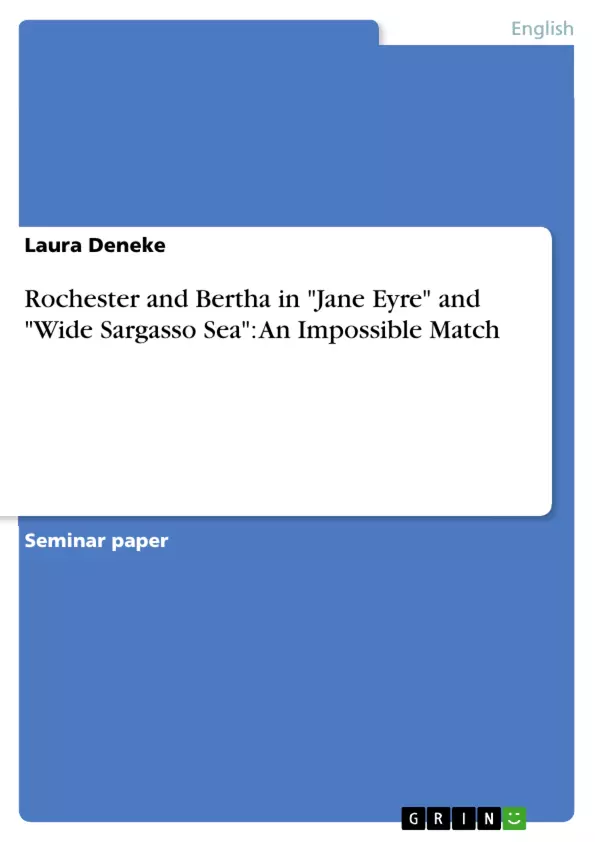Bertha Mason in Charlotte Brontë’s Jane Eyre is a character without history or personality. She is depicted as a mere beast, bent on destroying her husband. The reader knows -and dreads- her from both Jane’s and Rochester’s perspective. Rochester claims that Bertha’s lunacy was the sole trigger for the disaster that followed, but the narration reveals hints that suggest other factors may have contributed to the destruction of their marriage. Jean Rhys proposed a past for Bertha and her husband. Her novel Wide Sargasso Sea creates a life for Bertha, on the background of which her madness is neither surprising nor inevitable. Whereas there is no doubt that she does become insane at the end of Rhys’s novel, the reason for this is not her evil nature but a destructive relationship along with her transportation away from everything she ever knew into the cold of England. Wide Sargasso Sea is more than a prequel to a famous Victorian novel. It speaks out not only for Bertha but for all the other West Indian women who found themselves in similar situations.
Inhaltsverzeichnis (Table of Contents)
- I. Introduction
- II. Bertha Mason in Jane Eyre
- III. Antoinette and Rochester in Wide Sargasso Sea
- 1. Cultural Differences
- a) Rochester's Perception of the West Indian Landscape
- b) Race Relations
- 2. The Families's Intervention
- 3. Communication Problems
- 4. Antoinette's Prior Experience with English Gentlemen
- 5. The Road Towards Madness
- 1. Cultural Differences
- IV. The Significance of Wide Sargasso Sea
- V. Conclusion
Zielsetzung und Themenschwerpunkte (Objectives and Key Themes)
This paper examines the portrayal of Bertha Mason in Charlotte Brontë's Jane Eyre and her backstory in Jean Rhys's Wide Sargasso Sea. The objective is to explore the factors that contribute to Bertha's mental deterioration and to analyze the portrayal of the relationship between Bertha and Rochester through both novels.
- The representation of Bertha Mason in Victorian literature
- The impact of colonialism on gender and identity
- The dynamics of power and control in relationships
- The complexities of mental illness and its depiction in literature
- The significance of Wide Sargasso Sea as a prequel and feminist critique
Zusammenfassung der Kapitel (Chapter Summaries)
The first chapter introduces the concept of Bertha Mason as a character with a limited history and voice in Jane Eyre. It explores how she is presented through the perspectives of Jane and Rochester, who depict her as a dangerous and destructive figure. The chapter then examines the portrayal of Bertha in Wide Sargasso Sea, where she is given a backstory that sheds light on the origins of her mental breakdown.
The second chapter focuses on Bertha Mason's portrayal in Jane Eyre, exploring her limited appearances and the various ways in which she is characterized as a wild and savage creature. The chapter analyzes how the reader is prepared to see her as a dangerous figure and how she is ultimately reduced to a symbolic representation of a threat. The final scene of Bertha's appearance in the novel is analyzed, highlighting the image of her as a monstrous and uncontrollable figure.
The third chapter examines the relationship between Antoinette and Rochester in Wide Sargasso Sea, exploring the various factors that contribute to their incompatibility and eventual breakdown. The chapter focuses on their cultural differences, the influence of their families, communication problems, and Antoinette's prior experiences with English gentlemen. It explores the impact of the West Indian landscape and the colonial context on their relationship.
Schlüsselwörter (Keywords)
This study centers around the keywords: Bertha Mason, Jane Eyre, Wide Sargasso Sea, colonialism, gender, identity, mental illness, relationship dynamics, power, control, feminist critique, Victorian literature, and the West Indies.
- Quote paper
- Laura Deneke (Author), 2005, Rochester and Bertha in "Jane Eyre" and "Wide Sargasso Sea": An Impossible Match, Munich, GRIN Verlag, https://www.grin.com/document/65346



